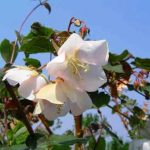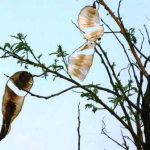TREE LIFE
SEPTEMBER 1992
MASHONALAND CALENDAR
Tuesday 1st September : Botanic Garden Walk with Tom Muller at 4.45 for 5.00 pm. Park at the Herbarium. It will be a good opportunity to hand in the seeds collected so far for Tom. The list of wanted seeds is too long for publication but if required phone Maureen on 739711 for a copy. Tom has got a big project in mind and needs almost all species.
Sunday 20th September : To Lance Perry’s farm Mpondaminga/Kilmacdaugh Estate, on the Dyke. Rob Burrett will give us a talk on the history of the area, members of the Aloe Society will join us at some point during the day and there’s lots of interesting bush to explore.
Saturday 26th September: with Mark at the ‘Balancing Rocks’ , Epworth at 3 p.m. Take the Chiremba (Widdecombe) Road out of town. Beyond the built up area look on the left for brick gate posts and wrought iron gate with the sign – “Balancing Rocks”. There is a $2 entrance fee. We will meet at the Giants‘ Playground parking area. I don’t think we have ever treed here so it will be interesting.
Monday, 28th September : Mr Lyn Mullin is showing more of his magnificent slides on “Trees of Note”. Once again Lyn and the History Society have extended an invitation to all who’d like to attend the show which will be at the Beit Hall, Prince Edward school at 5.30 for 5.45 pm. Tea will be served at hall and there will be a silver collection for a worthy cause.
Tuesday 6th October : Botanic Garden walk.
For a gents green pullover left at Golden Star Ranch Shamva in July please phone Maureen Silva-Jones on 739711. Is its yours Nick ?
MATABELELAND CALENDAR
Sunday 13th September : Please note that this is a second Sunday meeting because we shall be combining with the Aloe and Cactus Society on their usual day, for a lecture and slide presentation by the cycad expert Brian Schlacter. The venue is the house of Barbara and Derek Viljoen at 42 Fairbridge Way Malindela. Time 10.30 for 11.00 am. Please bring chairs, lunch afterwards at Mabukuweni, catering by John Coulson at $8,00 a head. There will be a cash bar. Members who requirelunch please phone ,Clem von Vliet (41619) or Ian McCausland (41946) before the 6th September.
Monday 14th September : ‘Urban Trail’ Rendezvous at Woodlands Service Station on the Old Esigodini Road at 5 pm.
Sunday 4th October : A visit to a wonderful indigenous tree nursery run by the Williams‘ at Turk Mine. An opportunity to see green leaves in October, This will be a half day visit so bring chairs and tea. Rendezvous at the City Hall car park for an 8.30 am departure.
MATABELELAND BRANCH: REGINA RUINS : FORT RIXON
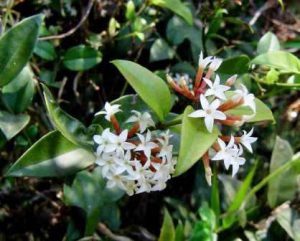
Carissa bispinosa. Photo: Bart Wursten. Source: Flora of Zimbabwe
The gravel road from the Harare Road to the Schur’s farm ‘Makovani’ proved to be remarkably good, but very dusty, not unexpectedly! The homestead, surrounded by lush green lawns, bordered by tall shady trees, was a veritable oasis, teeming with birdlife, set in the midst of a parched landscape. Jeanette served a delicious tea in the garden, in warm sunshine. It was after eleven o’clock: by the time we arrived at Regina Ruins. As mentioned in Rob Burrett’s article in the August Tree Life, one expects to find certain species at these sites, Regina being no exception. There were large specimens of Euphorbia ingens, Erythrina latissima, E.lysistemon, Celtis africana, but no Cussonia within the ruins area although we found Cussonia arborea, on the neighbouring kopje. There were too, Combretum molle, Lannea discolor, Aloe excelsa and a wealth of new growth emerging through the debris at the foot of the walls including Carissa bispinosa, C.edulis, Cassine aethiopica, C.transvaalensis, Euclea divinorum, E.natalensis, Ficus cordata, Olea europea and Sericanthe andongensis. We paused to admire and speculate upon the beautifully executed stone drain pipes/ventilation shafts sunk into the ground, the small sections of patterned wall which remained and the stone tables/seats then headed for a nearby well-treed granite outcrop. Two very well-used dolly’s (mortar holes) attracted our attention and not far away we came upon a collection of banded ironstone pestles. A dozen or more Faurea saligna ranging from young saplings to old mature trees were clothed in beautiful shades of red and green. Many of the trees were leafless but we did manage to identify Heteropyxis denniae, Brachystegia glaucescens, Cassius matabelica, Dombeya rotundifolia, Erythroxylumemarginetum, Gardenia terniiolia, Piliostigma thonningii, Pseudolactnostylis maprouneifolia, Rhus lancea, R.leptodictya, R.pyroides, Stychnos cocculoides and S.spinosa. On the plain were Acacia fleckii, A.gerradii and A.sieberana. After lunch, John Bishop acted as spokesman in thanking Ken for his work as Chairman and presented him with a walking stick (strictly ornamental as stressed by Geoff) as a token of appreciation from the members of the branch. Before leaving the area we stopped just across the river at the site of Cumnings store and walked a short distance to the grave of Sgt O’Leury who was killed in 1896. We found Diospyros lyciodes, Combretum erythrophyllum, C.hereroense and Rhus tenuinervis. Unfortunately time did not allow for further botanizing as there are some well wooded inviting gomos just waiting to be explored. A big thank you to Jeanette and Stan for opening their home to us en route. We recorded 69 species.
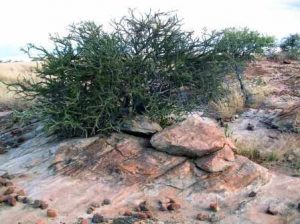
Boscia foetida. Photo: Rob Barrett. Source: Flora of Zimbabwe
A specimen of what Charles thought was Boscia foetida was sent to Harare for identification/confirmation and we saw what he thought might be Synadenium gazense growing among the rocks, pink-stemmed, leafless, very small branchlets, phallic, two to three meters in height. MMc
NGEZI 8 — 12 AUGUST l992
With a few wrong turns at rural signposts and a very corrugated road we entered Ngezi Recreational Park and in due course met up with the Hydes at the lodge. A late afternoon walk on a grassy plain, which was once the dam, with Mark giving an interesting insight into veld grasses. Despite the dryness a wide variety of trees were noted giving a final total of 125 species. Maureen’s knowledge of tree bark proving helpful.
The following day’s treeing was on and around a massive granite dwala named Sacred Hill. Once off the “lake” fringes and into the Mopane woodland with many rocky outcrops, Rhus tenuinervis and R.lancea occurred in number along with Lannea discolor. Three of the Strychnos family occurred in the same area, S.pungens, S.potatorum and S.spinosa, very handy for comparing one with the other. Figs too were present in the rocky parts, large (Ficus sycomorus in deeper soil, whilst F.ingens and F.sur preferred rock crevices. The scarlet racemes of Aloe excelsa were busily attended by Scarlet Chested Sunbirds, while on the dryer parts Commiphora mollis and Euphorbia ingens blended in with the rocky outcrops.
Once on the hill and nearing the summit an unusual Vitex with malformed leaflets beckoned us to stop for a while. Much reference to C.P. drew a blank, but it was later identified at the Herbarium V.mombassae. At the summit surrounded by Euphorbia matabelensis, a rock croft grew marginally as everybody added a stone of their choice before searching for a sheltered lunch stop away from the biting wind.
After lunch a ramble downhill towards the road, Hexalobus monopetalus and Zahna africana were recorded as well as a Cussonia natalensis, the only one of the day.
Returning to the lodge, Azanza garkeana marked a busier section of the road, while Terminalia sericea was steadily invading the surrounding bush. A small cluster of Acacia seeds were seen on a bare patch of ground, maybe dropped by accident as there were no Acacias in this area.
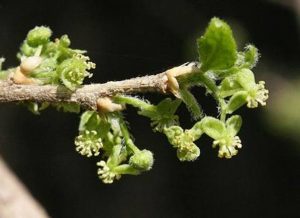
Erythrococca trichogyne. Photo: Mark Hyde. Source: Flora of Zimbabwe
After some tea a ramble around the lodge in the rocks disturbed a feeding bushbuck ewe who disappeared like lightening. Also seen in the vicinity were Erythrococca trichogyne, Grewia flavescens and Tarenna neurophglla. After an interesting hour or so wandering about the surrounds we returned to the lodge having had a really interesting day.
Having seen nil Acacias the previous day, day two had much promise. The first A.rehmanniana enticed us into the bush and within minutes A.nilctica, A.karoo and Ochna pulchra had been noted every where, including growing on bare rocks next to the Ngezi River gauging station.
Having met up with Linda – who had driven on ahead, we all enbussed and continued along a road that leads to the dyke hills and eventually Kadoma. A very dry and dusty acacia with small pods and leaflets was noticed and turned out to be A.fleckii. The masterpiece of the day was Rhus tenuipes, its leaves thin and highly serrated and being green made a pleasant change to the drab surrounds.
Lunch was eaten alongside the Ngezi River just outside the park boundary with Tetradenia riparia and Nuxia oppositifolia making a change from everlasting Syzgium guineense.
A mid-afternoon stop on the dyke for some more ‘tea’ , a nearby firebreak, gave Mark the opportunity to collect some Tapiphyllum velutinum. A harsh snort from a Zebra reminded us that we were not the only ones on the ridge. Once in the game park a herd of Sable, once aware of the vehicle vanished into the surrounding wood work.
For day three an area known as Chombe, some 20 km south of Ngezi was chosen for treeing. Apart from a couple of superb kudu bulls and an unusual Zonkey in a roadside kraal the dry bush did not seem very interesting. After crossing the Munyati River via a low level bridge things began to charge.
Wandering across from the road to an enormous sandbar next to the river we passed many large Bolusanthus speciosus and Acacia goetzii. On the river bank Ficus ingens and Fisuc sur snaked their way among the rocks with Lannea discolor and Elephantorrhiza goetzii well protected by boulders against (possible) floodwaters. It was then that the gorge came into view. A mass of enormous, jumbled boulders, polished black and a trickle of water passing below. Some fancy footwork and dry rocks enabled us to continue up the other side, well populated with Euohorbia griseola and E.ingens and a Ficus abutilifolia clinging to its almost vertical home added a splash of green to a sun baked rock face. Further into the gorge deep, stagnant pools with a pale turquoise colour along with a number of potholes, though nothing like those cavities on the Odzi River bed at Mapor Estate.
Following a path over the hill, Brachystegia woodland seemed to dominate but Burkea africana and several Gardenia ternjfolia were noticed. Approaching the wild date palms Phoenix reclinata clustered along the bank and with careful movements we all slithered and clutched our way down a rock face into the dry river bed. On a sandbar Mimusops zeyheri. On a sand bar Mimusops zeyheri, Cassine matabelica and C.aethiopica were flourishing despite the invading Dichrostachys cinerea.
After wandering up the next river bank we passed a badly cracked swimming pool and piles of rubble from what was once a homestead. All that remained intact was a reservoir and a section of someone’s driveway.
Some 10 km away and bypassing the now defunct Windsor Mine it was time for ‘tea’ and lunch. A wander up the road and a stiff climb up a nearby kopjie produced a Pappea capensis. Returning by vehicle the road to the Munyati River gauging station looked interesting and we stopped near the river. After a pleasant few minutes skimming stones on the river and noting Uapaca kirkiana and Steganotaenia araliacea, the wind chilled and we headed for our woolies.
The final day always seems to be flat but it was not to be for at the Umsweswe River, Maureen found a budding Acakanthera oppositifolia and Andrew Hyde found that falling into scummy water is yuk!!
A midday stop in Mopane woodland produced all sorts of interesting flora. A grove of robust Balanites aegyptiaca, Cadaba termitaria (interesting) and Vepris zambesiaca (most interesting) with its unusual winged rachis. A few Combretum imberbe were also noted. With the sun coming through the Mopane trees this made a ‘lekker’ spot for treeing, AND TEA.
Considering how dry the bush was and the limited leaf cover it was a superb extra. Many thanks to Fiona for organising the booking, Mark, Linda and family for all you did especially for the copious cups of tea and transporting us.
-BABE IN THE WOOD ‘
JULY 1992 VISIT T0 SHAMVA
This was the Society’s third visit to Golden Star and The Range as the guests of Aubrey and Edone Ann Logan. The first was in November 1981, and the second in February 1985.
The intervening years have not been particularly kind to the indigenous vegetation. New lands have had to be opened up – though this has been done with care and sensitivity – and a dam site cleared; stretches of woodland bordering the riverine, as well as the riverine vegetation itself, have been uprooted by gold panners despite protest; the influx of such people has led also o random chopping, very difficult to police; and some plants appear to be under stress after a succession of dry seasons.
The resilience of our vegetation has saved a lot of it from the ravages of man and nature for a long time. Given half a chance, it will do so again. Every year, in that part of the country, from July to September, nature assumes a cloak of listlessness under which it prepares for the miracle of spring. We hope soon to see, again, the surge of fresh life and colour, and rains to follow. Meanwhile, without complacency but with thankfulness, we rejoice that there is still a lot to delight the eye.
Since the last visit, the Society has welcomed —to its ranks, a considerable number of new members. The plan for the day was to share with them, and with other guests whom we were very glad to see, the novelty of some tree species not frequently encountered in the course of a relaxed single—day excursion from Harare, and here and there, to take in other plant occurrences of interest.
Among the latter were two figs. One of them, Ficus thoninggii had overwhelmed an Acacia goetzei. Only in the upper reaches did any sizeable branch of the Acacia emerge from the mass of entwined Ficus roots that were welded into a substantial trunk. While the over-possessive nature of F.thoninggii is frequently demonstrated, we don’t often see F.ingens in action. We did so later in the day, at the river, where a stately F.ingens (which Aubrey can remember as a big tree in his school days) appeared to be protecting a young Bequaertiodendron magalismontanum. The protective stance was doubtless illusory, but it was of interest to see a fig tree seeming to play host to another tree, instead of enveloping a tree more mature than itself. It will be watched. Other Ficus spp. on the farm are Ficus sur, F.sycomorus and the rough leaved, riverine F.capreifolia, all of which we glanced at in the course of the day. F.sansibarica is there but we had not time to visit it. F.nigro-punctata is in the area – for example, down river at Chipoli where the Society has seen it – but it has not been recorded on the farm.
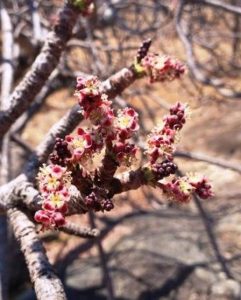
Sclerocarya birrea. Photo: Rob Barrett. Source: Flora of Zimbabwe
Among the trees at, and near, the homestead was a fine old Marula, Sclerocarya birrea. Its generic name is made up of the Greek “skleros” meaning “hard”, and “Kargon” meaning “nut” or “stone of a fruit”. The nut is in fact extremely difficult to crack or open, but the kernels are delicious and nutritious. The pulp is an acquired taste, but also nutritious and best known for the jams, jellies, and intoxicating brew into which it can be transformed. Our Matabele colleagues are far more familiar with the tree than are we. We looked at one of the male Marula trees too, and, to the extent that it was possible to pass around a photograph album at lunch time, at a colour print of the male flower. The photograph was taken in October, at which time of the year, the male tree can be quite a sight, with catkins of red bud coming out before the new leaves, and opening into pinkish—white flowers. I’ve not seen this in profusion, but even a modest show of it is memorable. Benedicta Graves has recorded a tree with both male and bisexual flowers on it. (Mrs Eileen McBean’s marula biscuits used to be a feature of the tea break at our A.G..M’s).
In our examination of Crossopteryx febrifugum, a rubiate, we were reminded by members less forgetful than I, of the crystalline inner-surface of the bark. Flakes of bark showed this clearly. Not surprisingly, its common name is “crystal back”. It is reputed to be one of the “ordeal” trees. Its small flowers are quite fragrant at the year’s end. The specific name febrifugum – from the claim that the bark provides a fever remedy.
In its monthly jottings, the Society has frequently touched upon the Commiphora almost hallowed place as the source of frankincense and myrrh. The most I celebrated of the Commiphora species were C.myrrha and C.gileadensis, the balm of Gilead. (I say were in case the specific names have been changed while we’ve not been looking.) We spent a sociable ten minutes moulding and testing the gum of C.mossambicensis. The tree supplied it readily. A little heat, if only from the friction of the fingers, increased its malleability and (it was claimed) its fragrance. C.mossambicensis is one of four Commiphoras on the farm. Its bark is smooth, it is not thorny, and its 3-foliolate leaflets are rounded until they curve in to form a drawn-out tip, quite large as Commiphora -leaflets go, but soft and graceful, with margins entire.
The oblong seed compartments of the large, flat, winged fruit pod of Xeroderris stuhlmanni were a source of interest. So also, on a second Xeroderris, fifty metres away, were the round cherry-sized galls that sometimes festoon the tree, looking for all the world like fruit. The gall is formed when the ovary of the flower is parasitised.
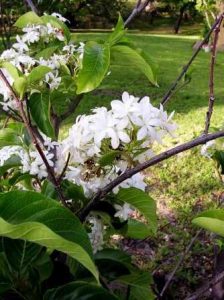
Holarrhena pubescens. Photo: Colin Wenman. Source: Flora of Zimbabwe
A little “jasmine tree”, Holarrhena pubescens – not at its best at this time of year – retained one of its long, slender, paired fruit pods, split to display a few remaining pin – thin seeds, on silky parachutes designed for distribution in the wind. In flower, this is one of our loveliest indigenous garden plants. It belongs to the Oleander family (APOCYNACEAE), in which several of the genera, such as Diplorhynchus, Tabernaemontana, Rauvolfia and Holarrhena itself, have paired fruits, other members of the family such as Carissa, which we saw later, do not.
Phyllanthus reticulates put up a particularly good show. This usually unobtrusive shrub was full of flower for us to see and sniff at – to confirm that this was indeed the source of the “potato smell” (for want of a better description) so often wafted in the evening breeze, over one’s holiday camps on the Zambesi or the Lundi or the Limpopo. The scent is variously described as conjuring up in the senses, “the strange odour of potatoes” (our own Palgrave), “the odd smell similar to that of baked potatoes” (Van Wyk), and the “homely smell . . . of half-cooked potatoes” (Palmer and Pitman). I wonder if members would care to offer alternatives or refinements.
The slim twigs along which the fairly small, simple, alternate leaves of Phyllanthus reticulatus grow, angle out from thicker branchlets, and give the impression of being compound leaves with alternate leaflets. It is in the axils of the simple leaves (a lot of which are fallen by now) that the small green to yellow to coppery flowers, both male and female, are crowded together on short branchlets. Its tiny berries ripen to black.
Easily confused with it at times is another member of EUPHORBIACEAE, the snowberry, Flueggea virosa. As the common name implies however, its fruit, a similarly small berry, is white when mature. Its simple, alternate leaves are on branchlets that take off from branches described by Palgrave as angular and some what rigid, tiny, greenish, male and female flowers are on different plants, few or solitary in leaf axils.
The farm is well endowed with Albizias. In our walk, the relatively large leaflets of Albizia versicolor stood out among the few still verdant canopies. John Candy confirmed that the green pod of this tree, when scattered by the wind, is poisonous to stock. A.amara and A.harveyi, in plentiful supply, provided the opportunity for on the spot comparison of the leaflets of the two species. Those of A.amara were noticeably finer and more symmetric, and they were on larger leaves and more numerous pinnae that gave a fuller overall cover to the tree, than was the case with A.harveyi. In the latter with its less dense cover, the leaflets were, to the eye, quite distinctly sickle-shaped.
A single specimen of Albizia tanganicensis has been recorded on the farm well outside the limits of our route. Two Albizia species-nave been introduced near the homestead – the one intentionally, as a fast growing, attractive shade tree, and the other by mistake. It thrives in its new environment, and has been used, with others, to line the streets of Shamva. The other Albizia introduced was A.chinensis, an exotic. This was due to a mix-up in one of Harare’s garden nurseries. It also has done quite well. It is one of the fine-leaf varieties.
A tassel berry bush, Antidesma venosum was looked at briefly, near the house. It occurs with more frequency near the river. Its fairly_large, glossy green alternate leaves are attractive and, as a very unscientific aid to those who do not know it well, I would say that if, in the Shamva bush near the Mazowe River, you think you see a guava tree, it is almost sure to be Antidesma if it isn’t a guava. Like, Pseudolachnostylis and Uapaca in the same family, EUPHORBIACEAE, the Antidesma is dioecious, that is to say it has unisexual lowers, the male flowers on one tree and the female on another. The young inflorescences are sometimes parasitised by an insect, and this results in a distorted, many branched, sterile growth, not dissimilar to the parasitized clusters of deformity often seen on Waterberry trees (Syzygium). However, the unparasitised, healthy flowers produce a pleasing display of small White-to-red-to purple fruit, on pendulous spikes, which give the plant the common name, Tasselberry.
There are 9 species of Combretum on the farm, none of them unfamiliar. It need only be noted, I think, that the clusters of large pods on C.zeyheri were striking, the “claw marks” on the trunks of the River combretum, C.erythrophyllum, provided, as always, a talking point, and the coppery leaves of C.adenogonium in whorls of 3 and 4, were admired as they deserved to be. The “mouse-eared” combretum, C.hereroense, was seen, and attention was drawn to the climbing C.mossambicense, notable for it showy white shaving brush” flowers later in the year and often 5-winged pods. Then there was .micrcophyllum. The latter is called the Burning bush combretum, because of its spectacular display of crimson clusters, at much the same time as C.mossambicense flowers in white. The C.microphyllum flowers give way to young, pink 4-winged-fruit pods, most handsome in the mass.
One of the most common trees on the farm is Bauhinia petersiana, the White bauhinia. Its lobed leaves were everywhere on view. The crinlkly white petals of the flower, with pink stamens, won’t be seen for some time yet. We did not get the chance to examine the yellow bauhinia (B.tomentosa), or, for that matter the other lobe-leafed tree on the farm, Piliostigma thoningii, although large specimens were to be seen from the tractor-drawn trailers in the afternoon.
At one stage during the morning we cut rather cautiously into the stem of the creeper Cissus integrifolia, in the hope of exrtracting water. If it is cut with the correct technique which I suspect I did not have, it can provide water quite copiously to the thirsty wanderer in the bush. We had no luck with this one, mainly, I think, because deep knife-wound scars below our unsuccessful cuts indicated that we had been forestalled in the not to distant past. The inside of the stem was green and moist, but that was all. The mature stem of Combretum microphyllem is said also to be a source of water to some degree. According to D.H. Grainger in “Don’t die in the bundu”, the theory is that climbing plants often have sap-conducting vessels under pressure in the stem, and this is released when cut. Its a fascinating subject, but I must add Grainer’s warning – to treat all climbers with caution, because the sap of some of them is poisonous.
Time caught up with us in our wanderings, and other pockets of interest had to be by-passed. Tessa, though, in a. sortie nearby, found a young Markhamia zanzibarica. It was not far from the termite mound on which stood an imposing Lannea schweinfurthii. We viewed that from a little distance, within easy range also of a thorny scrambling Capparis tomentosa, a Friesoclielsia obovata shrub which bears red pods of refreshing fruit, and a Dalbergia melanoxylon tree (the Blackwood Dalbergia) all untidy, small protruberances and small roundish leaflets. When at its best, D.melanoxylon yields a magnificent dark heartwood.
Some of the highlights came in the afternoon, after a relaxing lunch break under the trees on the lawn. We looked first at Cordia pilosissima, with its fairly large round leaves typically multi-trunked. The specific name means ‘”very hairy”, and that is precisely what the leaves are, on both surfaces. Then came Maerua kirkii, new, I think, to most visitors. Like the Capparis tomentosa scrambler mentioned above, it belongs to the CASPER family, CAPPARAEAE – and was, in fact, known as Capparis kirkii at one time. The better known M.angolensis was to be seen in several places, well shaped in the main, with soft leaves on long slender petioles. Vegetatively, M.kirkii bears not the slightest resemblance. On the farm it is multi-stemmed and rigid. Its simple sharp-tipped unyielding leaves are coarse and very strongly veined, with the veins deeply impressed on the dark, green upper surface, and standing out in sheer relief on the under surface. Its fruit, small-apricot-like in appearance (turning orange in colour) is quite unlike the “bead bean” for which Muerua agolensis is known (and which M.triphylla tries to emulate). Only when the green sepals, and long stamens of the flower appear in October or thereabout, does M.kirkii disclose its relationship to those species we know better in this part of the country.
En route to the river, we paused at a spruit to have a look at two or three splendid Ekebergia capensis trees, and with them, Nuxia oppositifolia in bud. On the opposite side of the road was a particularly fine Berchemia discolor, its wide-spread crown dark shiny green as if it were summer. It is a member of the family RHAMNACEAE, like the better-known Ziziphus. Its most notable feature was the beauty of its leaves which have been described as “distinctive and handsome dark green above and paler below . . . untoothed … the lateral veins … and the midrib raised below and beautifully neat and even“. Perhaps it was its noble appearance that brought to mind the use of Berchemia wood, by the Zulus, for the Chief’s Knobkerrie. It is, I find, Berchemia zeyheri, the Red Ivory tree, that has that distinction, and not this close relation. I apologize for my error.
A handsome Rauvolfia caffra stood out on the near approach to the river, and on arrival there several large Flacourtia indica trees, their trunks armed with stout thorns 8 cm long almost threatened to bar our path. The gems awaiting us beyond -included Diosoyros mespiliformis, Rhus quartiniana, Mimusops zeyheri, Ochna rovumensis and Millettia usaramensis. The first three we saw with some little frequency. As regards the last four — Garcinia livingstonei secretes a yellow sap, as does the species with which we are more familiar, the Garcinia of the granite kopjes, G.buchananii. It looks stiff and angular in growth form though, and its leaves are in whorls of 3 or 4, wider and more ovate than those of G.buchananii. While the leaf margins can be wavy as in the other species, they are not always entire.
Dalbergia arbutifolia (family PAPILIONOIDEAE) is a climber, very much at home on this stretch of the Mazowe .. The compound leaves are alternate and imparipinnate, and the leaflets are alternate in very regular rows and fairly closely spaced to give a striking leafy cover to any tree or rock over which it is draped.
Ochna rovumensis is an attractive shrub which, in this area, seems to grow only 1 to 2m—high and to have a strong affinity for rocky crevices on the banks of the river. Its finely serrated, alternate leaves, up to 6 cm long, taper both at the base and the apex, and tend to be wavy. Palgrave calls it the closed fruit Ochna because, for a long time after it flowers, the showy, red, persistent sepals remain curving over the fruit, before finally opening right out. The Mazowe river at Shamva is probably near the southernmost extremity of its range. The specific name stems from the Rovuma River, which runs between Mozambique and Tanzania.
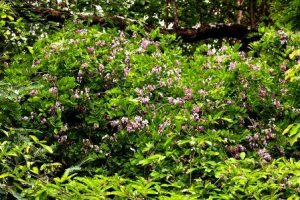
Millettia usaramensis. Photo: Bart Wursten. Source: Flora of Zimbabwe
Millettia usaramensis is another member of the PAPILIOIIOIDEAE family, as was Dalbergia, described above. Its alternate, compound leaves show a bit of a swelling at the base of the rachis, and its opposite leaflets (with a terminal one) are thin and light and mostly oval shaped to round. The leaflets can in fact be quite variable, sometimes with the base noticeably flat and straight before they begin to curve upwards. The sprays of mauve pea flowers are sheer glory in December or soon after when the season is right. We have had this on the Christmas table.
If there is another visit to the area we must be sure to spend a little time with Pericopsis angolernis and Kirkia acuminata. They are so prominent a feature out there that they are rather taken for granted.
Some 25% of the species mentioned above as occurring on the farm (by no means a comprehensive list) have an edible fruit. This seems to me to be about par for the course, almost wherever we go on our one-day outings.
Family ties apart, Edone and I were grateful as Tee Society members to Aubrey and Edone Ann and their young family for their hospitality, transport arrangements and all the other caring measures taken for our comfort and ease of access. It made tree-viewing a more-than-ever relaxing pastime.
-Dick Petheram
PAX PARK 16 AUGUST 1992
Vivid red Rhus leptodictya contrasting with bright green Commiphora marlothii made outstanding features at Pax Park.
Although very much Msasa country, the Girl Guides camp yielded a surprising number of trees despite the drought. Fiona‘s “Grewia Guide,” made short work of identifying G.Flavescens and G.monticola . Pouzolzia mixta with a few shrivellcd leaves shared surroundings with a spindly but still fruiting Strychncs spinosa. The bright green gourds having already been inspected by monkeys.
Along the park boundary fence (or what was left of it) Acacia polyacantha and Protea gaguedi grew alongside loads of young Terminalia sericea. Upsetting a pair of water buck caused a small herd of wildebeest to watch our movements until we wandered away.
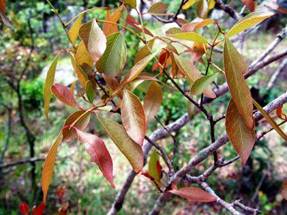
Pleurostylia africana. Photo: Rob Barrett. Source: Flora of Zimbabwe
A sudden rapid movement of the other party indicated ‘lunch’ and not wanting to be left out we headed ‘food wards‘ passings Pleurostylia africana, Vitex payos and a Cussonia arborea, causing Bob some anguish as the bark for some reason resembled an Erythrina latissima seen earlier.
After lunch Linda suggested some bushman paintings on a nearby kopje. Various children swarmed up the rocks followed by the adults (much slower)! The main painting consisting of kudu, figures with spears and a single warthog was in very good condition. Around the otherside of the rock, two gourd like details were all that remained of the painting. Diospyros natalensis and Euclea natalensis occurred in number as did the dassies, to judge by the amount of droppings. At the base of the outcrop Maureen found a Tricalysia niamensis and Vangeriopsis lanciflora which made interesting additions to the list.
For those who continued onto Bushman’s Point after the outing, the bird life was well worth watching. A Goliath Heron flapping lazily over the lake, Egrets clustered noisily on a rockv island and a Hammerkop attempting to court a mate with a stick in its beak. Lady luck continued to smile as on the return trip leaving the National Park, a White Rhino mum and infant were grazing near the road – what a treat.
Despite August being a difficult month for ‘treeing’ a total of 55 species including Mark’s Pterolobium stellatum were recorded in a relatively small area. Many thanks to the Girl Guides Association for the use of Pax Park.
-BABE IN THE WOOD
HILLSIDE DAMS WALK: WEDNESDAY 18th AUGUST 1992
August must be the very worst of months to look at trees in Zimbabwe and just when despair seems total, one comes across the first stirrings of spring. Erythrina lysistemon is in flower and so are Maerua, Boscia and Cadaba. The latter three lack the showmanship of Erythrina but their flowers are nevertheless fascinating, especially those of Cadaba. But we will hear more of these next month when instead of visiting the Hillside Dams we will on Monday 14th September potter around a square in Ilanda, which is a veritable garden of capers. The rendezvous will be Woodlands Service Station on the Old Esigodini road.
The Hillside Dams area is very dry indeed, almost everything is leafless and one wonders whether a session on some of the extra floral and foliar characteristics of trees might not be profitable. However, Rhus lancea, Cassine matabelica and C.transvaalensis as well as Carissa edulis are bravely showing some green. So we took a look at them, in some cases for a second time.
Rhus lancea which we had seen two months ago is now in full flower, so we examined the minute sweetly scented blooms. Earlier on in the day, pottering amongst the capers in Ilanda, I had come across Carissa bispinosa growing almost as profusely as Cadaba termitaria, so I picked a couple of specimens to use as comparative material with the abundant Carissa edulis of the Hillside Dams. The geometry of C.bispinosa is quite marvellous in its regularity. Two, as its specific name suggests, is its very special number. A pair of heart shaped leaves, set opposite, marks a branching point from which a pair of branchlets and a pair of bi-furcated spines originate. Since the base of the spine and the base of the branchlets are almost as stout as each other, and because they are set at right-angles to each other, this structure, in plan, takes on a distinct cruciform appearance. Further along the stem and springing from exactly half-way between each branching point one finds another pair of heart-shaped leaves. These two are always set decussately to the lower pair at the branching point. All leaflets sit snugly against the stem and appear to be sessile but an amputation will reveal a short curved petiole. The pattern – leaf pair, branch pair and spine pair, leaf pair again, is repeated without variation like some wonderful form of botanical “Leggo”, as one moves upwards and outwards.
I had recently found Cassine matabelica in sapling and coppice growth (survivors of last year’s fire) near the lower dam which brings the count for CELASTRACEAE at Hillside up to six. Since introductions had already been made to four of the family early this year, I thought it was only fair to make the new member known. Only Catha edulis and Cassine aethiopica now need to be traced to fill the complement of eight, CELASTRACEAE cousins on the Bulawayo District card.
-IAN MCCAUSLAND
NYARUPINDA CATCHMENT
The Scene Never before have the residents of Ayrshire District* seen so much activity on the farms cutting and baling hay to be sent to the ranchers in Matabeleland and the Low Veld. This is an expensive operation because it requires a lot of machinery; tractors, mower, rake or windrower, baler and transport to the pick up place for the onward journey.
* the approximate boundaries of this district are the rivers Manyame, Mukwadzi, Muvare and the Great Dyke range of hills.
At the time of writing this (August 5th) there are 15 railway wagons ready to be filled with hay bales at Banket on 6th and 7th August.
Oh to be on a termite mound at sunset to see the crystals glisten amidst pure white hairs on the leaves of Ehretia amoena, if you cannot be there someone will collect leaves for you to look at with the help of a 10x lens or a magnifying glass; thank you C.C.v.V. for a delightful way to remember sandpaper bush. The Ehretia most abundant in this catchment is E.amoena, it is more difficult to find the twiggy shrub E.rigida, aptly named puzzle bush, which is no problem for insects, they make its branches sticky which attract more insects and consequently birds, the jagged pattern of the twigs may afford some protection to the insects. Soon the misty mauve flowers of Ehretia app. will melt into the spring sky, later their small orange-coloured berries will be taken by fruit-eaters.
The Moringa Tree
In the scheme of things MORINGACEAE comes between the drought-tolerant families CAPPARACEAE and CRASSULACEAE, names come to mind … capers, Cadaba, Boscia and Maerua belong to the former and stately small orange-coloured flowered Kalanehoe lanceolata belongs to the latter family. H.F. Macmillan who was in charge of in his book “Tropical Planting and Gardening” published in 1935. However, he did not mention its use to purify water. The author must have liked horse radish because he said that the root of this tree was a poor substitute for the real thing, its immature pods were sliced like beans and used as a curry vegetable, the seeds contained a fine oil – Oil of Ben, used by watch makers and in cosmetics. The tree was propagated from seed and cuttings. Africa needs a boon let us hope that its water purifying ability is economically viable, but first we must have rain.
Protea Flowers
Nowhere can a diagram of the parts of a Protea floret be found! A single floret is baffling in its simplicity. My desk is littered with the remains of two dissected inflorescenees and granular masses of droppings from their insect visitors. Each hairy nutlet has along persistent style, it looks as if it belongs in a trout fisherman’s box of flies. Three fused perianth parts (tepals) end in a furry slender spoon like structure, the single tepal is formed in the same way. At this stage of the examination of the floret it is difficult to decide whether its four stamens are present, this is the moment to ask for professional advice. The part of the style below the stigma is called the pollen presenter, it ends where there is a kink in the style. Strasburger’s “Textbook of Botany” published in 1908! does not do justice to PROTEACEE, there is nothing about structure or pollination of the plants belonging to this family. Unfortunately the Protea Atlas Newsletters to date have not included this topic, perhaps the editor of P.A.N. would enlighten us, he might be chuffed to receive a letter from Zimbabwe, especially now that Kim St.J.D. has left us. The newsletters are illustrated, so the information requested may take the form of diagrams which could be amusing as well as educational. Botanists have illustrated Proteas since the year 1605 when a drawing of what is now P.neriifolia was likened to a thistle head and was called Carduus, one of the genera of thistles. ‘
African Civets in the Catchment
Our secretary sent me information about the civet, the correct name for their dung heap is civetry, there are no less than three of these a short distance from this house; they are being watched month by month because they are very interesting. There is no truer expression than to be ‘as greedy as a civet‘.
In that magnificent book “Mammals of the Southern African Subregion” Mr. Smithers stated that pods of Cassia petersiana were eaten by the civet, this species is not listed on the Mashonaland Field Card of Trees and Shrubs. The information came just at the right moment and has coincided with the ripening of Cassia singeana fruit, would not these be the next best thing? Their ripe yellow/black pods have a slightly sweet taste but the seeds are indigestible. The characteristics of this seed were noted. In particular there was a small oval indentation off-centre on each side of the lentil-like seed, these matched exactly those found recently in two of the three civetries. ’ This was the observeer’s beginners luck. Tom Muller said it is not easy to tell what you find in their dung. Amongst the miscellaneous items that pass through civets there was one prickle sheathed in bark, this may occur when a tree flushes with growth e.g. Erythrina spp. a strange thing to happen in winter after a drought; this may not the the only explanation but will suffice for the moment.
My nature study consultant is Paul Zwanikken who lives among the ‘gomos‘ on the south eastern side of the Nyarapinda river. He comments on the contents of the civetry and thought that the black and white feathers came from a Tropical Boubou Shrike; the long shiny black tapering bristle was undoubtedly from the crest of a porcupine, possibly the parent of the tender morsel which was eaten by the civet. On a recent ride the groom pointed out the poroupines’ main road to Kashawa kopje. Another day we saw antbear and impala spoor in the same patch of sand. The drought has altered the distribution of the latter, it was the first sighting of impala spoor near here.
New Blooms
Odds and ends from the bush accumulate on the table and window sill to remind me what to write in these letters, here are a few notes about them: there are flowering twigs of Turraca nilotica, Rhus longipes, Ximenia Americana. The flowers of Erythrina abyssinica are too prickly, out of reach and rather sparse this season. There are spring-loaded seeds hanging out of Acacia gerrardii pods, just pull these down and see how they spring back. Broken dry fruits of monkey bread tree and the spent persistent flowers of Ormocarpum krkiii together with vlei spice Sphacranthus peduncularis and vild basil called Ocimum canum have nostalgic scents. The writer was introduced to the vlei spices on the flood plain at Ruckomechi by Garth Thomson when the Tree Society went there in that very wet April in 1986.
The best find this month has been a cup-shaped birds nest smaller than a tennis ball, its walls are felted with plant down, horse hair and flower stalks. This nest is as cosy as that of the Grey Penduline Tit. Providence made me look down at the ground to find it.
-Benadicta Graves
GEORGE HALL CHAIRMAN


